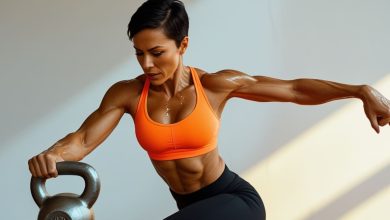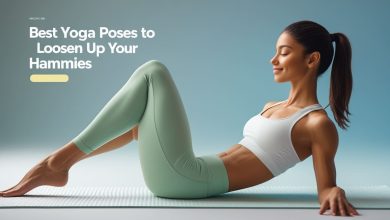The Ultimate Daily Stretching Routine for Beginners: Unlock Flexibility and Boost Energy
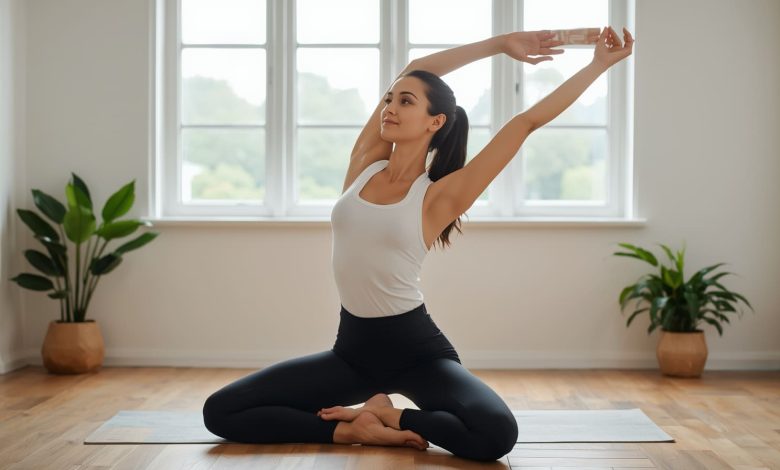
Daily stretching routine for beginners is the perfect way to start your fitness journey, especially if you’re new to exercise or have a sedentary lifestyle. Many beginners worry about not being flexible enough or not knowing the proper techniques. But the truth is, this daily stretching routine for beginners doesn’t have to be complicated or time-consuming. A short daily practice can dramatically improve your flexibility, reduce muscle tension, enhance posture, and even boost your mood.
According to the Mayo Clinic, regular stretching can significantly improve your joint range of motion and blood circulation. This comprehensive guide will walk you through a complete daily stretching routine for beginners, including detailed step-by-step instructions, scientific benefits, and practical tips to make stretching an enjoyable part of your daily life.
Why Stretching is Crucial for Beginners: The Science Behind the Benefits
Many beginners underestimate the importance of stretching, dismissing it as something only athletes or yoga enthusiasts need. However, research shows that stretching offers multiple scientifically-backed benefits that are particularly valuable for those just starting their fitness journey.
Improves Flexibility & Mobility
Regular stretching increases muscle length and improves flexibility, helping you move more freely in daily activities and during workouts. Consistent stretching over several weeks can significantly improve range of motion in major joints. This means everyday activities like bending to tie your shoes, reaching for items on high shelves, or simply turning to look behind you become easier and more comfortable.
Reduces Muscle Tension & Stress
Sitting at a desk or performing repetitive motions can tighten muscles, leading to discomfort and restricted movement. Stretching releases this tension and activates the parasympathetic nervous system, promoting relaxation. When you stretch, you’re not just helping your muscles—you’re also sending signals to your brain to calm down. This mind-body connection makes stretching an excellent tool for managing daily stress and anxiety.
Enhances Circulation & Recovery
Gentle stretches enhance circulation to muscles and joints, improving oxygen delivery and speeding up recovery. Better circulation means more nutrients reaching your muscles and faster removal of metabolic waste products. This is particularly important if you’re just starting to exercise, as your body needs efficient recovery mechanisms to adapt to new physical demands.
Prevents Injury
Flexible muscles and joints are less prone to strains and sprains. Proper stretching can significantly reduce injury risk during physical activities. Regular stretching improves muscle elasticity and joint mobility, creating a more resilient body that’s better prepared for unexpected movements or physical challenges.
How to Prepare for Your Stretching Routine: Setting Yourself Up for Success
Proper preparation makes your stretching routine safer, more effective, and more enjoyable. Here’s everything you need to know to get started.
Essential Equipment:
- Yoga Mat: Provides cushioning and stability for floor exercises. We recommend checking our guide to the best yoga mats for beginners if you’re in the market for one.
- Comfortable Clothing: Choose clothes that allow full range of motion without restriction. Stretchy fabrics like cotton blends or technical performance materials work best.
- Water Bottle: Stay hydrated throughout your routine. Proper hydration helps maintain muscle elasticity.
Pre-Stretch Checklist:
- Find a quiet, comfortable space where you won’t be interrupted
- Wear loose, comfortable clothing that doesn’t restrict movement
- Warm up slightly with light movements like marching in place or arm circles
- Focus on deep, steady breathing to prepare your mind and body
Understanding Different Types of Stretching
As a beginner, it’s helpful to understand that not all stretching is the same. This routine focuses on static stretching (holding positions), which is ideal for improving flexibility and cooling down. Once you master this routine, you might explore dynamic stretching for warm-ups or PNF stretching for advanced flexibility.
Complete Daily Stretching Routine: Step-by-Step Guide
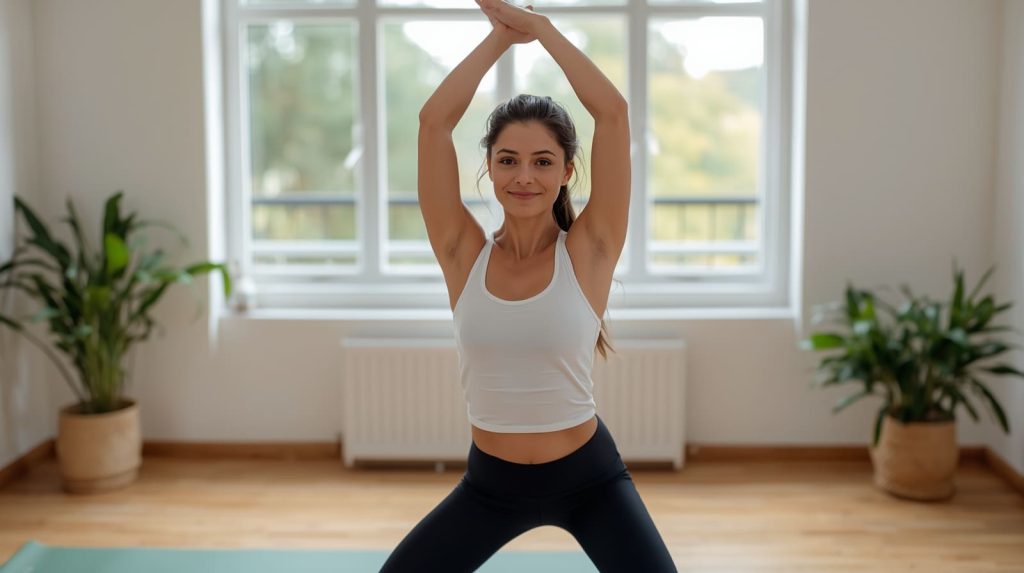
Hold each stretch for twenty to thirty seconds. Breathe deeply and never push through pain. Remember that flexibility varies daily—some days you’ll feel more limber than others.
Neck Stretch
Detailed Instructions: Sit or stand tall with your shoulders relaxed. Gently tilt your head to the right, bringing your ear toward your shoulder. Use your right hand to deepen the stretch slightly, but avoid pulling aggressively. Keep your left shoulder relaxed and down. You should feel a gentle stretch along the left side of your neck.
Benefits: Relieves tension from desk work and improves neck mobility. This is particularly beneficial if you spend long hours looking at screens.
Common Mistakes: Rounding shoulders forward, pulling too hard, or tilting head forward instead of directly to the side.
Shoulder Rolls
Detailed Instructions: Stand or sit with a straight spine, arms relaxed at your sides. Slowly roll your shoulders up toward your ears, then back and down in a smooth circular motion. Complete several rolls forward, then reverse direction. Focus on making the circles as large and controlled as possible.
Benefits: Improves posture and releases upper back tension. This movement helps counteract the forward shoulder position common in desk workers.
Pro Tip: Imagine you’re drawing large circles with your shoulder blades, moving them through their full range of motion.
Chest Opener
Detailed Instructions: Clasp your hands behind your back with palms facing each other. Straighten your arms and gently lift them away from your body while simultaneously lifting your chest and squeezing your shoulder blades together. Keep your chin slightly tucked to maintain proper neck alignment.
Benefits: Counters hunched posture from sitting and desk work. This stretch opens tight chest muscles that can contribute to poor posture.
Modification: If you can’t clasp hands, hold a towel or resistance band between your hands.
Cat-Cow Stretch
Detailed Instructions: Begin on all fours with wrists directly under shoulders and knees under hips. As you inhale, drop your belly toward the floor, lift your gaze upward, and tilt your tailbone up. As you exhale, round your spine upward, tuck your chin to your chest, and engage your abdominal muscles. Flow smoothly between these positions.
Benefits: Improves spinal flexibility and relieves back pain. This movement helps mobilize each vertebra and increases circulation to spinal discs.
Breathing Cue: Inhale as you move into Cow, exhale as you move into Cat.
Seated Forward Bend
Detailed Instructions: Sit on the floor with your legs extended straight in front of you. Inhale to lengthen your spine, and as you exhale, hinge forward from your hips. Reach for your toes, shins, or ankles—wherever you can reach comfortably. Keep a slight bend in your knees if needed to prevent straining your hamstrings.
Benefits: Stretches hamstrings and calms the nervous system. This pose is known for its relaxing effect on the mind and body.
Important: Focus on maintaining a long spine rather than rounding forward to touch your toes.
Hip Flexor Stretch
Detailed Instructions: Step your right foot forward into a lunge position, keeping your left knee on the ground. Ensure your right knee is directly above your right ankle. Gently push your hips forward until you feel a stretch in the front of your left hip. Keep your torso upright throughout the stretch.
Benefits: Counters effects of prolonged sitting. Tight hip flexors are extremely common in people who sit for extended periods and can contribute to back pain.
Deepen the Stretch: Raise your left arm overhead and lean slightly to the right.
Quadriceps Stretch
Detailed Instructions: Stand tall near a wall or chair for balance if needed. Bend your left knee and bring your heel toward your left glute. Grasp your left ankle with your left hand and gently pull it closer to your body. Keep your knees close together and your standing leg slightly bent. Avoid arching your back excessively.
Benefits: Essential for walkers, runners, and desk workers. The quadriceps are among the largest muscle groups in the body and benefit greatly from regular stretching.
Form Check: Ensure your bent knee points straight down toward the floor, not out to the side.
Calf Stretch
Detailed Instructions: Stand facing a wall with your hands placed on it for support. Step your right foot back, keeping both feet pointing forward. Press your right heel into the floor while bending your left knee. Keep your back leg straight for a full calf stretch.
Benefits: Prevents shin splints and improves ankle mobility. Tight calves can contribute to multiple foot and knee issues.
Variation: Try the stretch with your back foot turned slightly inward and outward to target different parts of the calf.
Side Stretch
Detailed Instructions: Stand tall with your feet hip-width apart. Raise your right arm overhead. As you exhale, gently lean to the left, creating a long arc from your right foot to your right fingertips. Avoid collapsing into the stretch—focus on lengthening both sides of your torso equally.
Benefits: Improves lateral flexibility and stretches intercostal muscles. This stretch enhances rib cage mobility, which can improve breathing capacity.
Breathing: Take deep breaths into the expanded side of your rib cage.
Child’s Pose
Detailed Instructions: Kneel on the floor with your big toes touching and knees wide apart. Sit back on your heels and fold forward, resting your forehead on the mat. Extend your arms forward or rest them alongside your body. Allow your entire body to relax into this restorative position.
Benefits: Reduces stress and provides full-back release. This pose gently stretches the hips, thighs, and ankles while promoting a sense of calm.
Modification: Place a pillow under your forehead or torso if you can’t comfortably reach the floor.
Expert Tips for Success: Making the Most of Your Routine
Consistency Over Intensity
Daily sessions are more effective than occasional long stretching sessions. Build the habit first, then consider increasing duration or frequency. Research shows that consistency is the single most important factor in improving flexibility. Set a daily reminder or pair your stretching with an existing habit to make it stick.
Breathing Technique
Inhale deeply before each stretch, exhale as you move deeper into the position. Proper breathing enhances relaxation and effectiveness. The American Lung Association emphasizes that controlled breathing can reduce blood pressure and promote feelings of calm. Try to make your exhalations longer than your inhalations for maximum relaxation.
Progress Gradually
Increase stretch duration slowly over time. Track your progress in a journal or app. Remember that flexibility gains are incremental—celebrate small improvements like being able to reach farther or hold a position with less discomfort. Our fitness progress tracker can help you monitor your journey.
Listen to Your Body
Mild discomfort is normal; sharp pain means you should stop immediately. Learn to distinguish between the “good hurt” of a productive stretch and the “bad hurt” of potential injury. Your flexibility will vary day to day based on factors like stress, hydration, and previous activity—adjust your intensity accordingly.
Common Mistakes to Avoid
Skipping Warm-up: Always include light movement before stretching cold muscles. A proper warm-up increases blood flow and prepares your nervous system for stretching.
Bouncing: Use static, held stretches rather than ballistic movements. Ballistic stretching (bouncing) triggers the stretch reflex, causing muscles to contract rather than relax.
Holding Breath: Maintain steady, deep breathing throughout. Breath-holding increases blood pressure and muscle tension—the opposite of what you want to achieve.
Comparing to Others: Focus on your own progress, not others’ flexibility. Flexibility is highly individual, influenced by genetics, age, gender, and activity history.
Rushing Through Stretches: Give each stretch your full attention. Mindful stretching is more effective and safer than mechanically moving through positions.
Making Stretching a Sustainable Habit
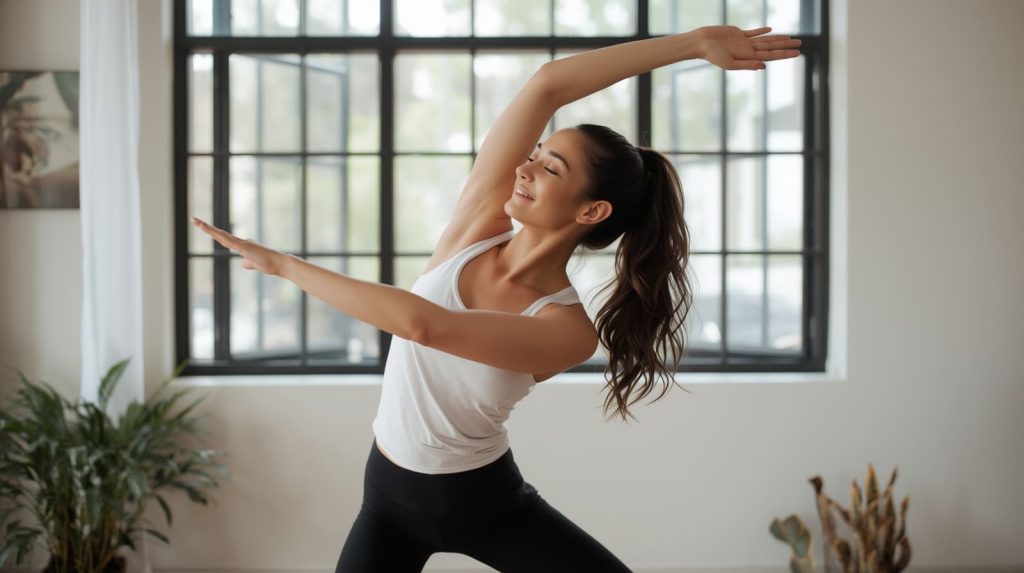
Morning Routine
Start your day with stretching to energize your body and mind. Morning stretching can improve circulation, reduce morning stiffness, and set a positive tone for your day. Focus on gentle, invigorating stretches rather than deep, intense ones first thing in the morning.
Work Breaks
Counteract desk fatigue with quick stretches every hour. Set a timer to remind yourself to stand up and move. Simple neck rolls, shoulder stretches, and standing calf raises can be done in your office without special equipment. These movement breaks prevent stiffness from setting in and can boost productivity.
Evening Wind-Down
Use gentle stretches before bed to improve sleep quality and release daily tension. Evening stretching has been shown to improve sleep quality in people with sleep problems. Focus on relaxing poses like Child’s Pose, seated forward bends, and gentle twists.
Post-Workout
Include stretching after exercise to aid recovery. Post-exercise stretching takes advantage of warmed-up muscles and can help reduce muscle soreness. This is the ideal time to work on improving your flexibility.
Frequently Asked Questions
How long should a daily stretching routine for beginners last?
A daily stretching routine for beginners should typically last between 10-15 minutes. This timeframe is ideal because it’s long enough to address all major muscle groups while being short enough to maintain consistency. Start with 10 minutes and gradually extend to 15 minutes as your flexibility improves. Remember that consistency matters more than duration – a shorter routine done regularly is better than a longer one that you skip frequently.
Can I modify this daily stretching routine for beginners if I have limited mobility?
Absolutely. This routine can and should be modified based on your individual mobility level. Use chairs for support during standing stretches, reduce the range of motion, and focus on gentle movements rather than deep stretches. For example, if you can’t reach your toes, use a stretching strap or towel. The key is listening to your body and never pushing through pain – discomfort is normal, but sharp pain means you should ease back.
What’s the best time of day to do this daily stretching routine for beginners?
The ideal time varies by individual preference and schedule. Morning stretching helps energize your body and prepare for the day, while evening stretching can release tension and improve sleep quality. Many beginners find late afternoon ideal when the body is naturally more flexible. Choose a time that fits consistently into your daily routine – the most important factor is maintaining regular practice rather than the specific time of day.
Do I need to warm up before starting my daily stretching routine?
Yes, a brief warm-up is recommended before stretching. Spend 2-3 minutes doing light cardio such as marching in place, arm circles, or gentle jogging on the spot. This increases blood flow to your muscles and prepares your body for stretching, reducing the risk of injury and making your stretches more effective.
How quickly will I see improvements in my flexibility?
Most beginners notice some improvement in flexibility within 2-3 weeks of consistent practice. Significant changes typically appear after 4-6 weeks. However, everyone progresses at their own pace – factors like age, genetics, and consistency all play a role. Focus on your personal journey rather than comparing your progress to others.
Conclusion: Your Journey to Better Flexibility Starts Today
Starting a Daily Stretching Routine: Boost Flexibility and Reduce Stress in Just 15 Minutes is one of the simplest yet most powerful investments you can make in your health. This daily routine requires no special equipment and can be done anywhere—your living room, office, or even a hotel room when traveling. The key is consistency – even on busy days, prioritize these few minutes for your body and mind.
Remember that flexibility progress is personal and non-linear. Some days will feel easier than others due to factors like stress, fatigue, or hydration levels. What matters is showing up consistently and listening to your body’s needs. The mental benefits—reduced stress, improved mind-body connection, and a sense of accomplishment—are just as valuable as the physical improvements.
Ready to transform your flexibility and reduce stress? Start today with this beginner-friendly routine and experience the life-changing benefits of regular stretching. Your future self will thank you for taking these few minutes each day to care for your body.New chat
